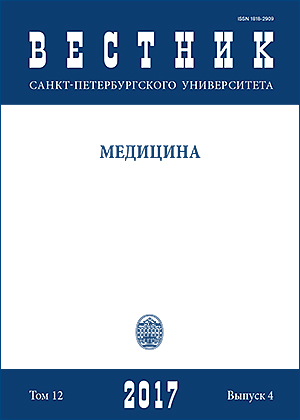NON-THROMBOTIC COMPLICATIONS OF PERMANENT VASCULAR ACCESS IN DIALYSIS CASES AND TECHNIQUES FOR THEIR SURGICAL CORRECTION
DOI:
https://doi.org/10.21638/11701/spbu11.2017.404Abstract
Rapid development of techniques for chronic hemodialysis in the latter part of the 20th century and in
the beginning of the present one enabled medicine not only to save the lives of millions of patients who
suffer from the terminal stage of chronic renal insufficiency but to significantly improve their quality of life. Advances in medical engineering and equipment as well as treatment approaches and potential for medicinal substitution of the lost renal functions, as well as a reduction of the treatment cost with chronic hemodialysis resulted in the ability of patients to receive correction of terminal renal insufficiency. Arterial-venous access for hemodialysis that can provide for a long effective cannula insertion in peripheral vessels was and still is the main “key” for a patient to be connected with the apparatus of “the artificial kidney”. Being, on the one hand, a great benefit for the patient, arterial venous access is nevertheless an artificial pathological formation that leads to a number of specific syndromes. The exponential increase of chronic hemodialysis in clinical practice and the consequential increase in the need for arterial-venous access determines the need for studies concerning the problems of complications related to these procedures. Urgent need for the study of complications caused by arterial venous accesses for hemodialysis is mainly motivated by the increase of the average age of patients with chronic hemodialysis and duration of the received treatment. Whereas conventional surgical operations in vessel surgery are actively replaced by endovascular interventions, a number of operations for forming and reconstruction of the arterial venous access continues to be growing. In the given article we present modern views for diagnostics and treatment strategy for the main complications of arterial venous access that are not related to thrombotic occlusion. Problems of surgical treatment of infectious and hemodynamic complications, treatment approaches with aneurysmal transformation of vessel access are also discussed in the article. Refs 67.
Keywords:
hemodialysis, permanent vascular access, arteriovenous fistulae, venous hypertension, aneurysms, seroma, ischemic monomelic neuropathy
Downloads
References
References
aureus infections among dialysis patients — United States, 2005. MMWR Morb. Mortal Wkly Rep., 2007,no. 56, p. 197.
A clustering of epidural abscesses in chronic hemodialysis patients: risks of salvaging access catheters in cases of infection. J. Am. Soc. Nephrol., 1996, no. 7, p. 2264.
infection with topical intranasal mupirocin: an evidence-based review. Clin. Infect. Dis., 2003, vol. 37,p. 933.
A comparison between PTFE and denatured homologous vein grafts for haemodialysis access: a prospective randomisedmulticentre trial. The SMASH Study Group. Study of graft materials in access for haemodialysis. Eur. J. Vasc. Endovasc. Surg., 1998, no. 16, p. 126.
preoperative evaluation of the subclavian vein in dialysis access planning. AJR Am. J. Roentgenol., 1991,no. 156, pp. 623–625.
Gregory R. T., Rutherford R. B., Kent K. C. Recommended standards for reports dealing with arteriovenous hemodialysis accesses. J. Vasc. Surg., 2002, no. 35, pp. 603–610.
and peripheral venous obstruction: a long-term multi-institutional experience. J. Vasc. Surg., 2000, no. 32,pp. 760–769.
vein interposition for salvage of a functioning arteriovenous fistula. Ann. Vasc. Surg., 2000, no. 14,pp. 679–682.
placement. J. Am. Coll. Surg., 2006, no. 203, pp. 506–511.
, 2008,no. 48, pp. 216–217.
Thomas, E. H. Lambert. 2nd ed. Philadelphia, 1984, pp. 1811–1825.
Acute cardiac failure secondary to brachiocephalic arteriovenous fistula in patient on chronic haemodialysis.
Pol. Arch. Med. Wewn., 2004, no. 112, p. 1221.
Long-term effects of arteriovenous fistula closure on echocardiographic functional and structural findings
in hemodialysis patients: a prospective study. Am. J. Kidney Dis., 2010, no. 55, p. 682.
Kooman J. P. The relation between vascular access flow and different types of vascular access with systemic
hemodynamics in hemodialysis patients. Artif Organs, 2005, no. 29, p. 960.
Hypertens., 2006, no. 15, pp. 353–360.
Kidney Int., 2006, no. 70, p. 765.
Dial.Transplant., 1984,no.13, pp. 635–638.
Brown S. T., McDonald J. C. Complications from permanent hemodialysis vascular access. Surgery, 1988,no. 104, pp. 681–686.
Reboldi G. Survival of vascular access during daily and three times a week hemodialysis. Clin.
Nephrol.,2000, no. 53, p. 372.
hemodialysis graft with placement of a stent graft. Semin. Interv. Radiol., 2007, no. 24, pp. 34–37.
salvaging failing dialysis access. Vasc. Endovasc. Surg., 2008, vol. 42, no. 3, pp. 228–234.
Downloads
Published
How to Cite
Issue
Section
License
Articles of "Vestnik of Saint Petersburg University. Medicine" are open access distributed under the terms of the License Agreement with Saint Petersburg State University, which permits to the authors unrestricted distribution and self-archiving free of charge.




